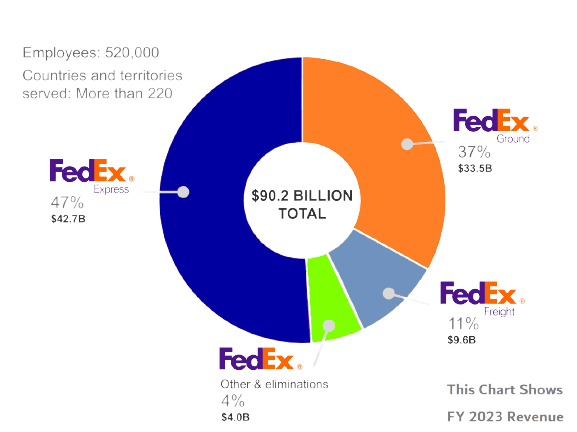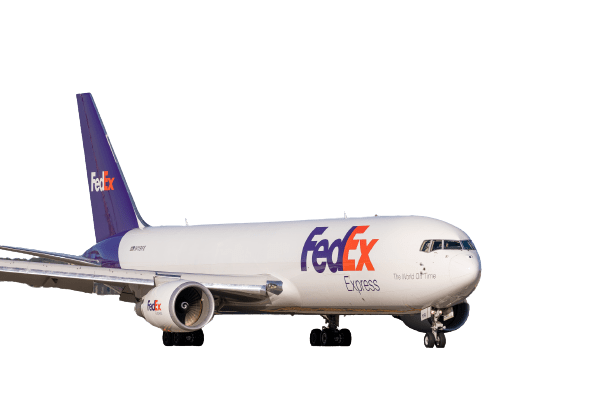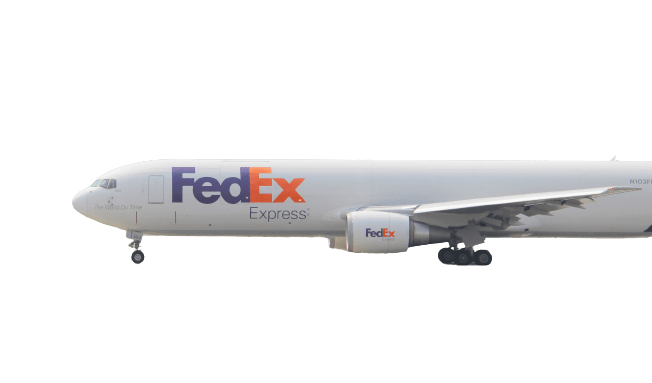- 8 November 2023
- No Comment
- 1613
The FedEx Story: How a College Term Paper Became a Logistics Empire

FedEx is not only a dominant player in the U.S. transport and logistics industry, with a 47.35% market share, but also a global leader in the courier, express, and parcel (CEP) market, with a 37.38% market share based on revenue. Total revenue for the fiscal year 2023 was $90.2 Billion.
market share, but also a global leader in the courier, express, and parcel (CEP) market, with a 37.38% market share based on revenue. Total revenue for the fiscal year 2023 was $90.2 Billion.
The company operates the largest fleet of Boeing 757 aircraft in the world, with 119 of them in its fleet. It also has a special division called FedEx Custom Critical, which handles the most urgent and sensitive shipments, such as live animals, human organs, artwork, and classified documents.
But how did FedEx start, and what challenges did it overcome to achieve its current position? This article is on the journey of FedEx, the world’s leading transportation and logistics company, from its inception as a college term paper to its recent consolidation of operating companies. We will also look at some of the innovations and achievements that made FedEx a pioneer and a leader in the industry.
Hello and welcome, I’m Nabeel Shaikh, a seasoned chartered accountant, investment banker, and management consultant with 17 years of experience. If you are a professional in logistics, courier service, or related fields, or if you are simply curious about how FedEx became such a successful and admired brand, then this article is for you.
The Idea That Changed the World of Logistics
The story of FedEx begins in 1965, when Frederick W. Smith, a Yale University undergraduate, wrote a term paper for his economics class. In his paper, Smith proposed a system that would accommodate time-sensitive shipments, such as medicine, computer parts, and electronics, by using a network of specially designed aircraft and vehicles. Smith argued that the existing delivery methods were inefficient and costly and that his system would create a competitive advantage for businesses that needed fast and reliable delivery.
He received an average grade for his paper, but he did not give up on his idea and continued to research the logistics industry, realizing that there was huge market potential for his system. He also gained some practical experience by serving in the U.S. Marine Corps as a platoon leader and a pilot.
The Birth of Federal Express
In 1971, Smith founded Federal Express Corporation in Little Rock, Arkansas, with an initial capital of $4 million raised from his family and friends. He also secured another $80 million in venture capital, making it one of the largest start-ups in U.S. history at the time.
His vision was to create an integrated air-ground express service that would deliver packages overnight to any address in the U.S. He hired a team of experts in aviation, engineering, and logistics to design and operate his system. He also acquired a fleet of 14 small aircraft, which he named “Falcon Jets”.
However, Smith faced many challenges and obstacles in launching his service. He had to deal with regulatory issues, legal battles, labor disputes, technical glitches, and fierce competition from established carriers. He also had to convince potential customers that his service was worth paying a premium for.
One of the most critical moments in FedEx’s history occurred on April 17, 1973, when Federal Express began operations in Memphis, Tennessee. That night, 14 Falcon Jets delivered 186 packages to 25 U.S. cities. It was the first time that an express delivery company used a hub-and-spoke system, where packages were sorted and transferred at a central location before being flown to their destinations.
FedEx Struggle for Survival
Despite its innovative service and technology, Federal Express struggled to gain market share and profitability in its first years. The company faced high operating costs, low demand, and cash flow problems. By 1976, Federal Express was losing over $1 million per month and was on the verge of bankruptcy.
Smith decided to take a bold gamble to save his company. He flew to Las Vegas with the last $5,000 of the company’s funds and played blackjack. He managed to win $27,000, which he used to cover the company’s fuel bill for the next week.
Fortunately, Smith’s luck did not end there. He also secured a major contract with the U.S. Department of Defense to transport military documents and equipment. He also launched a marketing campaign with the slogan “When it absolutely, positively has to be there overnight”, which resonated with customers who valued speed and reliability.
By 1976, Federal Express had produced its first profit of $3.6 million. Seven years later, Federal Express became the first U.S. company to reach revenues of $1 billion within 10 years of the startup with no merger or acquisition.
The Growth and Diversification
FedEx continued to grow and expand its services and network throughout the 1980s and 1990s. It introduced several innovations that changed industry standards, such as:
- The first drop box for customers to deposit their packages
- The first overnight letter service
- The first tracking system that allowed customers to monitor their shipments online
- The first express freight service
- The first international express service
Global Expansion
FedEx also made several acquisitions that helped it extend its reach and capabilities, such as:
| Gelco Express International | |
| Tiger International | |
| Evergreen International Airlines | |
| Caliber System and its subsidiaries: | |
| RPS | later renamed FedEx Ground |
| Roberts Express | later renamed FedEx Custom Critical |
| Viking Freight | later merged with FedEx Freight |
| Caribbean Transportation Services | later merged with FedEx Trade Networks |
| Caliber Logistics | later renamed FedEx Supply Chain |
| Caliber Technology | later merged with FedEx Services |
| Tower Group International | later renamed FedEx Trade Networks |
| Kinko’s | later renamed FedEx Office |
| Parcel Direct | later renamed FedEx SmartPost |
| ANC Holdings | later renamed FedEx UK |
| Prakash Air Freight | later renamed FedEx India |
| MultiPack | later renamed FedEx Mexico |
| Opek | later renamed FedEx Poland |
| TATEX | later renamed FedEx France |
| Rapidão Cometa | later renamed FedEx Brazil |
| Supaswift businesses | later merged with FedEx Express in Africa |
| Bongo International | later renamed FedEx Cross-Border |
FedEx: Rebranding
In 1994, Federal Express officially rebranded itself as FedEx, reflecting its global presence and diversified portfolio. FDX Corporation, the holding company of FedEx and its subsidiaries, changed its name to FedEx Corporation and rebranded all of its subsidiaries under the FedEx name in 2000.
FedEx: The Transformation and Consolidation
In the 21st century, FedEx faced new challenges and opportunities in the rapidly changing market environment. The company had to deal with rising fuel costs, security threats, environmental regulations, e-commerce growth, customer expectations, and competitive pressures.
These are some of the issues that FedEx faced in the 21st century and how they affected the company and its customers:
Rising fuel costs
Fuel is one of the major expenses for any transportation and logistics company. The price of fuel fluctuates depending on supply and demand, as well as geopolitical and environmental factors. When the fuel costs rise, the company has to either absorb the extra cost or pass it on to the customers, which can affect its profitability and competitiveness.
FedEx Express spent nearly $4 billion on jet fuel in 2022, which was 88% higher than the previous years due to rising fuel prices.
Security threats
The transportation and logistics industry is vulnerable to various security threats, such as terrorism, cyberattacks, theft, fraud, and sabotage.
In 2017, a ransomware attack caused FedEx to lose about $300 million. These threats can disrupt operations, damage assets, endanger employees, and compromise customer data and privacy. The company has to invest in security measures, such as screening, tracking, encryption, and insurance, to protect its network and customers.
Environmental regulations
The transportation and logistics industry is also subject to various environmental regulations, such as emission standards, carbon taxes, and waste management. These regulations aim to reduce the environmental impact and promote sustainability. The company has to comply with these regulations, which can increase its operational costs and complexity. The company also has to adopt green practices, such as using alternative fuels, optimizing routes, and recycling materials, to enhance its environmental performance and reputation.
E-commerce growth
The growth of e-commerce has created new opportunities and challenges for the transportation and logistics industry. On one hand, the e-commerce boom has increased the demand for fast and reliable delivery services, especially for online retailers and consumers. In 2022, U.S. online sales were estimated at $1.1 trillion, which is 17.3% of all retail sales.
On the other hand, the e-commerce market has also increased competition, complexity, and expectations for delivery services. The company has to offer more options, such as same-day, next-day, and weekend delivery, as well as more convenience, such as easy returns, tracking, and notifications, to meet the customer’s needs and preferences.
The report also indicated that more people would use digital money and pay later, and more people would buy things from other countries online.
Customer expectations
Customer expectations for the transportation and logistics industries have also changed and increased over time. Customers not only want fast and reliable delivery but also personalized and customized services. The customers also want more transparency, visibility, and control over their shipments. The company has to leverage technology, such as artificial intelligence, big data, and cloud computing, to enhance its customer experience and loyalty.
Competitive pressures
The transportation and logistics industry is highly competitive and dynamic, with many players and factors influencing the market. The company has to face competition from other established carriers, such as UPS, DHL, and Amazon, as well as from new entrants, such as regional and local players, startups, and disruptors.
The company also has to deal with external factors, such as economic conditions, trade policies, and consumer trends, that can affect the demand and supply of its services.
FedEx Action Plan to Counter Challenges
FedEx: DRIVE
To address these issues, FedEx launched a strategic transformation program called DRIVE, which stands for Deliver Results through Innovation and Value Enhancement. The program aims to improve the efficiency, profitability, and customer experience of FedEx by leveraging its technology, network, and people.
FedEx: Network 2.0
One of the key initiatives of DRIVE is Network 2.0, which is a multi-year effort to optimize the U.S. and Canada air-ground networks of FedEx. The initiative involves enhancing the sorting and routing capabilities, increasing the automation and digitalization of operations, and integrating the services and platforms of different FedEx operating companies.
FedEx: Consolidation
As part of this initiative, FedEx announced in April 2023 that it will consolidate its operating companies into one organization, creating a single company operating a unified, fully integrated air-ground network under the respected FedEx brand.
This phased transition, with full implementation expected in June 2024, will ultimately bring FedEx Express, FedEx Ground, FedEx Services, and other FedEx operating companies into the Federal Express Corporation.
However, FedEx Freight will continue to provide less-than-truckload freight transportation services as a stand-alone company under Federal Express Corporation.
Dealing with security threats
The company deals with security threats by implementing various measures and practices to protect its network and customers. Some of these measures and practices are:
They expect this organizational evolution to create even greater flexibility, efficiency, and intelligence to unlock value for customers, team members, and stockholders. As one FedEx team, the company is well positioned to execute its mission to help customers compete and win with the world’s smartest logistics network.
Lessons from FedEx’s Journey
FedEx’s story is a testament to the power of innovation, perseverance, and customer focus. Here are some of Nabeel Shaikh’s expert pieces of advice from FedEx’s journey that entrepreneurs and business leaders can learn from:
Invest in technology
Technology can play a transformative role in businesses of all sizes, helping to improve efficiency, reduce costs, and enhance customer service. FedEx has been a pioneer in the use of technology, and its commitment to innovation has been a key factor in its success.
Diversify your business
Diversification can help businesses reduce risk and expand their reach. FedEx has diversified its business from overnight delivery to include supply chain management, logistics consulting, and other related fields. This has helped the company weather economic downturns and maintain its growth trajectory.
Focus on customer satisfaction
Customers are the lifeblood of any business. FedEx has always prioritized customer satisfaction, and it has developed a reputation for providing reliable and innovative services. Businesses should focus on understanding and meeting the needs of their customers in order to build loyalty and drive growth.
Build a strong team
Employees are the most important asset of any business. FedEx has a strong track record of attracting and retaining top talent. Businesses should invest in their employees and create a positive work environment where they can thrive.
Persevere through challenges
No business is immune to challenges. FedEx has faced its own share of setbacks, but the company has always persevered and emerged stronger. Businesses should learn from their mistakes and keep moving forward, even in the face of adversity.
FedEx is a remarkable example of how a visionary idea can transform an industry and create a lasting impact on the world. From its humble beginnings as a college term paper to its current status as a global leader in logistics and e-commerce, FedEx has demonstrated its resilience, innovation, and excellence throughout its history.
As it embarks on its next phase of transformation and consolidation, FedEx is poised to continue delivering on its promise of connecting people with possibilities.
Read now: How Netflix Turned Around Its Business and Became a Streaming Giant







